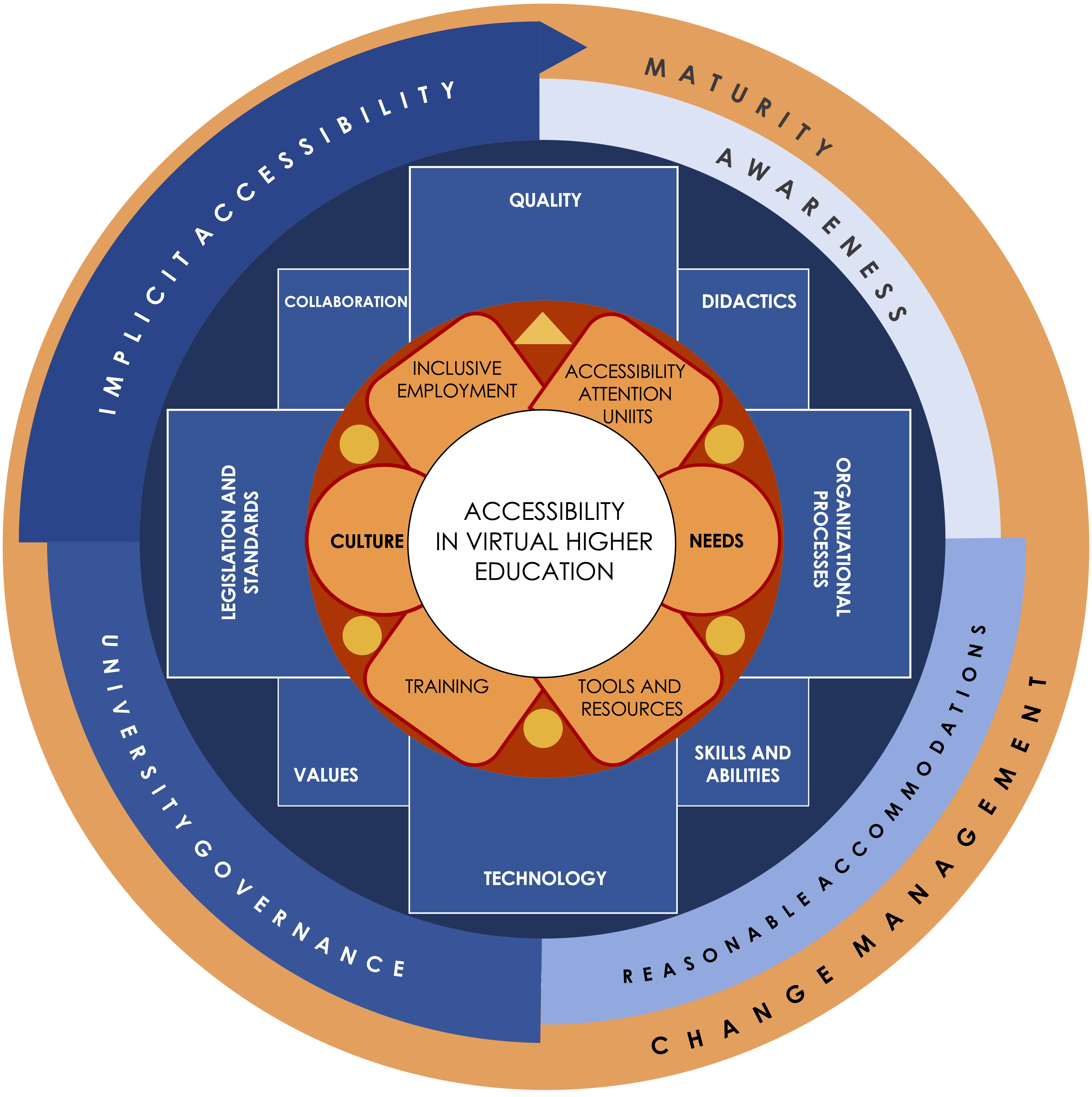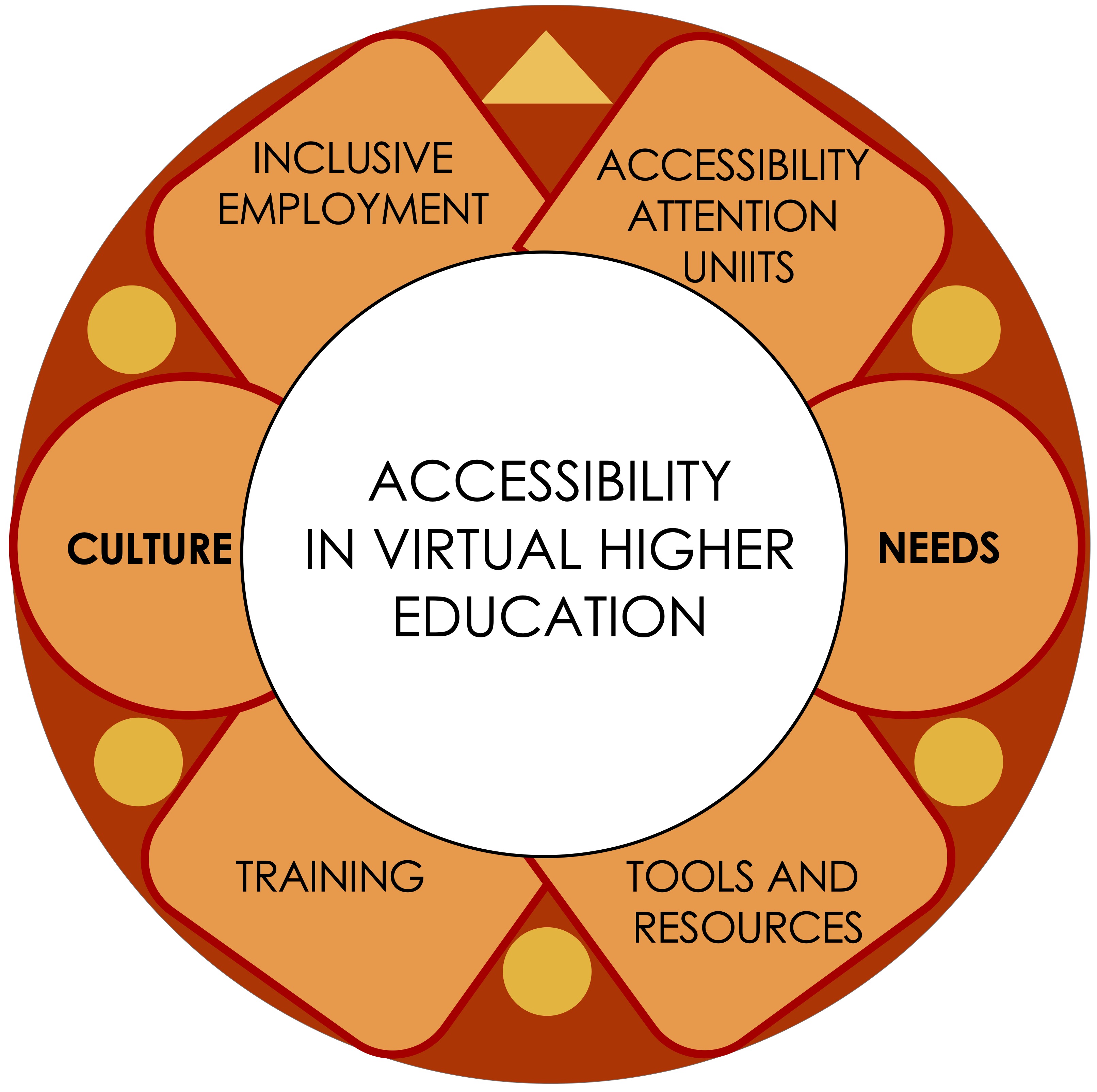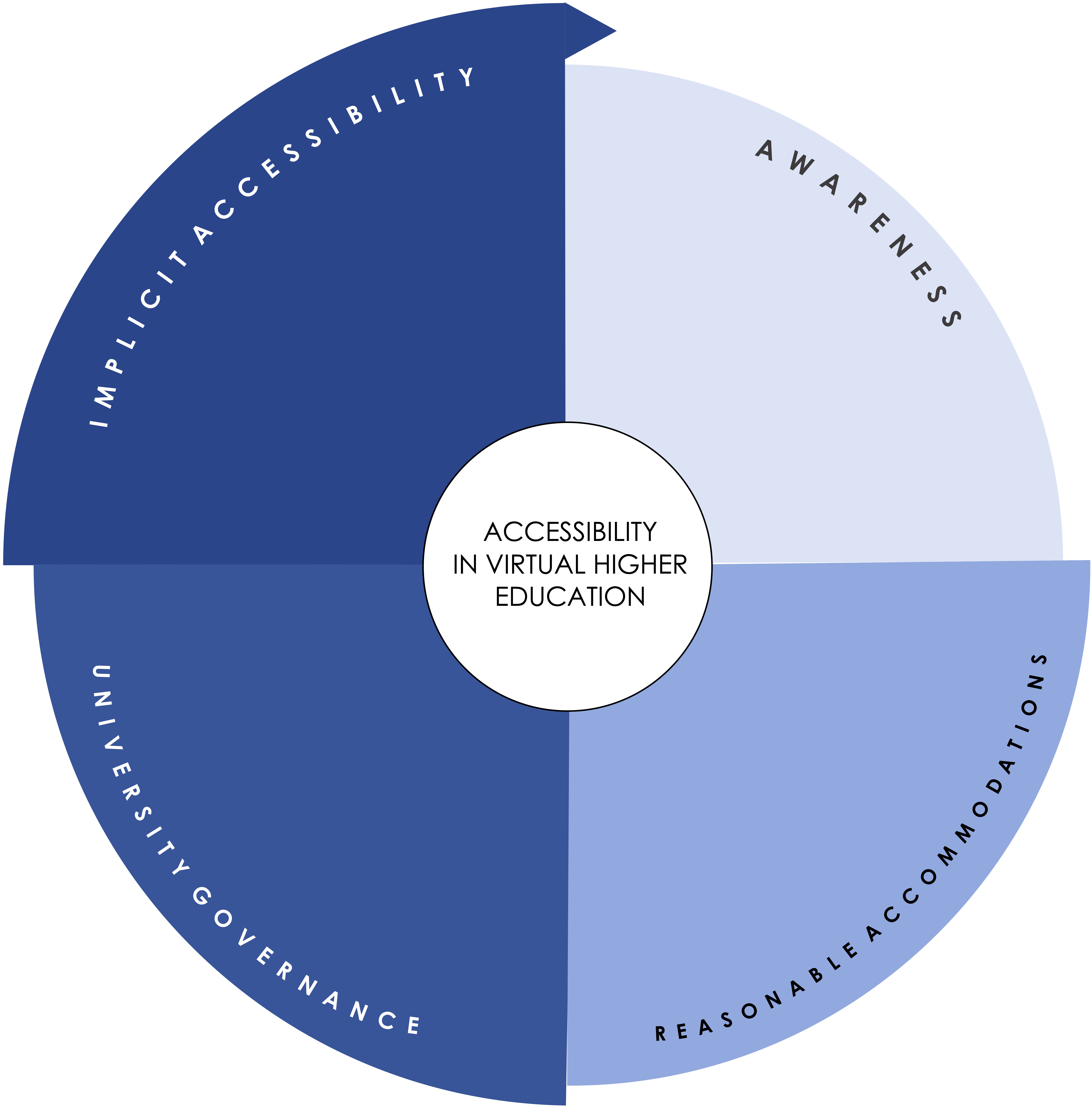
| Version | Summary | Created by | Modification | Content Size | Created at | Operation |
|---|---|---|---|---|---|---|
| 1 | Ricardo Mendoza-Gonzalez | -- | 1922 | 2023-10-15 04:27:03 | | | |
| 2 | Catherine Yang | -131 word(s) | 1791 | 2023-10-16 04:40:47 | | |
Video Upload Options
The SARS-CoV-2 Coronavirus pandemic (COVID-19) forced educational institutions to move their programs to the virtual world, revealing needs such as the lack of accessibility of online resources and content. In this context, the Erasmus+ project "Technological Assistance to Accessibility in Virtual Higher Education (EduTech)”, proposed tools and knowledge focused on improving accessibility in Higher Education Institutions (HEIs). In this article, a framework that integrates all the findings of the EduTech project is presented. The proposed framework is aimed at facilitating the adoption of good practices related to technological accessibility in HEI. The framework considers the limitations and needs of the institutions in terms of governance and resources for improving accessibility. The framework was adopted by four Latin American HEIs to establish a continuous improvement strategy according to their needs and current level of accessibility focus. This research also shows the results and suggests that the proposal is adaptable to the needs of HEIs, allowing its implementation regardless of their organizational structure and their current level of attention to accessibility.
1. Proposed Framework
The framework consists of three dimensions: START, DRIVERS and EVOLUTION. In addition, a cross-cutting dimension called "CHANGE MANAGEMENT" was incorporated. This dimension is essential to facilitate the adoption of the famework to create and initiative that improves accessibility in virtual higher education.
Figure 1 illustrates the framework proposed in this study. The Quincunx, the central element of the Aztec calendar, is also the central element of the proposed framework representing the START dimension. The next dimension, called DRIVERS, is represented by the Andean Cross, one of the most important symbols in Andean cosmology. Both symbols are planning instruments and were considered axes of the world in the context of their respective cultures. They represent cycles such as the seasons of the year, denoting harmony between complementary opposites and interactions between people, highlighting collaboration and harmony between community members [1][2]. This is also the origin of the name of the framework, Chakrana, a Quechua word meaning "to prepare the land for sowing". This represents the main objective of the framework, which is to assist in resource planning and overall preparation of the institutional context ("land preparation") to improve the accessibility of virtual higher education ("sowing").

Figure 1. Graphical representation of the Chakrana framework.
In the following subsections, the elements of each Chakrana dimension are described.
2. Start Dimension
This dimension focuses on the main objective of the framework - to contribute to the improvement of the accessibility of virtual higher education - considering the needs and culture of the HEI leading the initiative. Therefore, an initial evaluation of the current situation is needed to establish a baseline. Figure 2 illustrates this dimension through four esential actions (for more details, see section 4).
Action 1 - Accessibility Attention Units: Refers to the creation, implementation and management of Accessibility Attention Units in HEIs.
Action 2 - Tools and Resources: Refers to the development and implementation of accessible tools and resources for students with disabilities.
Action 3 - Training: Deals with the establishment of training strategies for those involved in the teaching and learning process in HEIs.
Action 4 - Inclusive Employment: Focuses on promoting and facilitating the inclusion of undergraduates in the labour market.

Figure 2. START dimension.
The actions and actors form a virtuous circle that is represented by the Quincunx. The main actors are the students, who are represented by a yellow triangle at the top. The other five actors, which are: 1) academic staff, 2) administrative staff, 3) institutional authorities, 4) governmental bodies and international organisations and 5) society in general, are represented by five circles interspersed between the four actions, as they are the ones who must drive them forward.
3. Drivers dimension
The elements that make up this dimension represent the synergy of four human factors ⸻didactics, skills and abilities, values, and collaboration⸻ and four functional factors ⸻quality, organizational processes, technology, and legislation and standards. These factors allow actors to influence the achievement of technological accessibility. Figure 3 illustrates how both sets of factors are intertwined and overlapped to give rise to the shape of the Andean Cross. These factors also cut across the four actions of the START dimension and are closely related to the people (actors) who implement them.

Figure 3. DRIVERS dimension.
4. Human Factors
Didactics. It is essential to train those involved in the teaching-learning process in active, accessible and inclusive teaching strategies and techniques to facilitate learning for all students with special emphasis on those with disabilities. Such techniques should place the learner in an active position, which encourages their participation in the professional teaching process. In this way, it is expected the acquisition of knowledge and the development of behaviours and generalising skills, i.e., the ability to transfer the skills and knowledge gained in one setting or task to another. These skills will prepare them to successfully face future challenges in their professional life, and to solve projects and tasks set by the teacher.
Skills and abilities. It is essential to know not only the abilities and limitations of students with disabilities, but also their particular situations. In addition, it is important to consider the skills and abilities of both academic and administrative staff in teaching - and learning - strategies. It is also essential to understand the materials and/or resources that mediate the educational function for all students, and the awareness and sensitization of students' particular situations to promote an accessible and inclusive educational environment.
Values. Higher education is key to achieve "well-being for society", however it which both a personal and professional to society. In other words, active promotion of diverse aspects, including diversity, equity and inclusion is required, as well as a deep understanding of the relationship between disability and accessibility, grounded in the ethical domain, processes and institutional guidelines. The ethical domain refers to an institutional perspective that encompasses "those activities that are based on their adherence to a set of ethical or moral standards or principles" [3]. The foundations of an inclusive culture are rooted in values that ensure the well-being and rights of the entire university community, extending to society as a whole.
Collaboration. It is essential to encourage the participation of all actors to ensure the proper implementation of actions in favor of an accessible and inclusive educational environment. In addition, it is important to establish effective communication channels between the institution and experts from other HEIs, organizations, foundations, governmental bodies, and companies. These actors can strengthen accessibility, inclusion and equity initiatives.
5. Functional factors
Quality. The services offered by the institution should be designed to meet the needs ⸺explicit or implicit⸺ - of students with disabilities. To do so, it is essential to clearly identify: 1) the goals and objectives, 2) the methods to achieve these goals and to educate and train the people involved, 3) the implementation of strategies to facilitate the necessary actions, 4) the definition of mechanisms to verify the impact of these actions, and 5) the determination of appropriate actions based on evaluations. These five aspects are fundamental to establish a process of continuous improvement, which should ideally be integrated into institutional quality processes, orienting efforts towards the achievement of total quality [4].
Technology. Information and communication technologies (ICT) represent a support to boost the functional and human factors described above. ICT promote an efficient flow of information and accessible resources, facilitate the coordination of work groups, and support students and academics, with or without disabilities. Some examples of ICT in this field are virtual campuses, 3D work simulators or open educational resources. However, there are several considerations for a proper implementation of ICT; for example, confidentiality and privacy of information, since sensitive data related to the personal circumstances of students and academics will be processed; or the appropriate visualisation of information on different devices and platforms.
Organizational Processes. Accessibility has a influence on the activities carried out in HEIs, the use of their resources, institutional objectives, and the results of such actions. Therefore, the necessary adaptations must be established so that institutional procedures work in a coordinated manner to mitigate the barriers that students with disabilities may face. This can only be achieved through the regulated collaboration of the people involved, the management of resources and infrastructure, the promotion of an accessible institutional culture and management strategies (strategic work plans) based on values.
Legislation and standards. It is crucial to consider both international and national guidelines that promote best practices, not only on accessibility such as WCAG standards, but also on universal design issues, so that they can be reflected in HEI processes, environments, and infrastructures.
6. Evolution Dimension
Figure 4 illustrates the EVOLUTION dimension, which encompasses four levels of maturity essential for achieving accessible virtual higher education. Progression through these levels is achieved through the actions proposed in the START dimension, which are supported by the human and functional factors that are included in the DRIVERS dimension.

Figure 4. Constituent elements of the EVOLUTION dimension.
The maturity levels are described below:
Awareness. This is considered the initial maturity level in the evolution of accessibility in virtual higher education. The promotion of awareness and sensitisation of the entire university community marks the beginning of actions to address the needs of students with disabilities. The aim is to ensure the full participation of students with disabilities ⸺valuing their individuality⸺ by promoting equal opportunities and non-discrimination in academic life.
Reasonable Accommodations. The second level of maturity involves identifying, planning, implementing, and evaluating modifications and adaptations to the physical, social, and attitudinal environment according to the specific needs of students with disabilities. These adaptations aim to ensure that students with disabilities exercise all their rights on an equal basis with others. This may involve the intervention not only of teachers, but also of authorities and other university staff.
University Governance. The third level of maturity focuses on the development of institutional management models, based on principles, actions and processes that promote values of diversity, equity, and inclusion as an integral part of institutional objectives. This approach should permeate the entire university community, starting with managers and authorities, to strengthen strategic planning and continuous improvement of its quality management systems. In addition, it should encourage indicator-based decision-making, participatory management, accountability, self-regulation, and institutional transparency, and foster an organisational culture that prioritises good university governance. Which, according to [5], refers to the set of structures and processes that are used for the planning and management of HEIs with emphasis on the role of the various actors in those structures and processes, such as regulators, administrators, teachers, students, communities, among others.
Implicit Accessibility. The highest level of maturity is conceptualized as a utopia, where all elements (processes, models, principles, instruments, spaces, services, infrastructure, and technology) are designed to promote and enable the fulfilment of the values of diversity, equity and inclusion, which in turn, are enhanced by the actions and behaviours of all people in the university community.
References
- Ocampo, E.; Bidon-Chanal, C. La piedra del sol: notas sobre la concepción del tiempo entre los aztecas, Bol. Amer., 1981, 31, pp. 173-185.
- Flores Rengifo, M. G. La Chakana y los saberes ancestrales del pueblo Kayambi. Universidad Central de Ecuador, 2018. Available online: URL http://www.dspace.uce.edu.ec/handle/25000/16876 accessed on August 17 2023).
- Schwartz, M. S.; Carroll, A. B. Corporate social responsibility: A three-domain approach. Busi. Eth. Quar., 2003, 13, pp. 503-530.
- Timbi-Sisalima, C.; Sánchez-Gordón, M.; Hilera-Gonzalez, J.R.; Otón-Tortosa, S. Quality Assurance in E-Learning: A Proposal from Accessibility to Sustainability. Sust., 2022, 14, 3052.
- Castellanos, F. H. Buen Gobierno en Educación Superior: Código de Buen Gobierno y Buenas Prácticas de Gestión. Ministerio de Educación, Colombia, 2014. Available online: URL https://sancionatorios.mineducacion.gov.co/files/conve/BUENGOBIERNOENIES.pdf.




